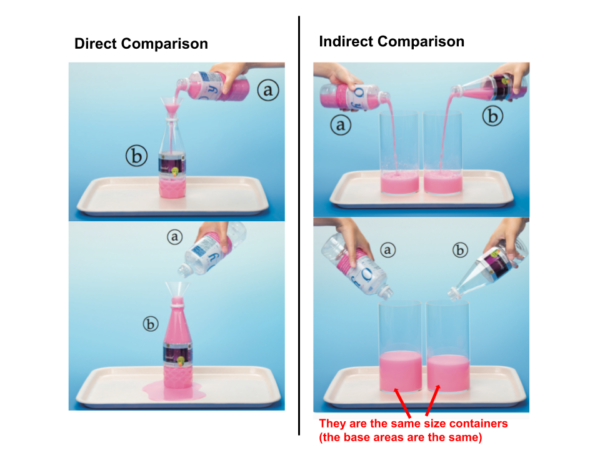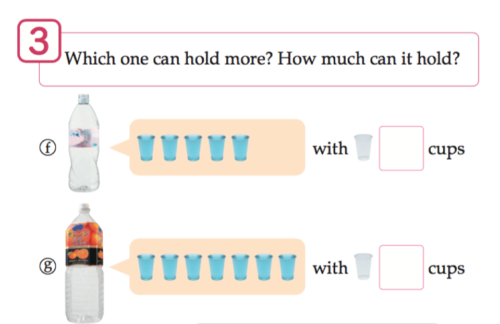The Surface of a Liquid in a Measuring Cup Should Be Read at the
The Four Stages of Measurement with Liquid Volume
Just equally with all measurement attributes (east.thousand. length, weight, etc), students do good from progressing through the four stages of measurement with liquid volume. Below, nosotros discuss experiences that can help students move through these stages.
Stage ane: Direct Comparison of Liquid Volumes
1 manner to directly compare the chapters of two containers is to fill up upwardly one container and transfer that corporeality of water into the other. If it overflows, the start container is bigger, or is able to hold more water. If all of the h2o from the first container tin be poured into the 2nd container without completely filling it, then the 2nd container holds more water.
Stage 2: Indirect Comparison of Liquid Volumes
1 manner to indirectly compare the capacities of two containers is to fill up both containers and cascade their content into two identical containers. By looking at the height of the liquid in the two containers, we can decide which container had more liquid.

Reproduced with permission from Tokyo Shoseki publishing company, Nihon. Mathematics International Grade 1, p. 91-92
Importantly, the size of the two containers that receive the content of the original two containers must be identical to make a judgement. We know that many young children judge the amount of liquid in a container based on its level (height of liquid) without paying attention to other dimensions of the container. This is something that teachers demand to continue in heed.. Teachers may straight accost this misconception by, for instance, having students pour out the same amount of liquid into two dissimilar containers. Teachers can likewise address this misconception during the straight comparison stage past helping students realize that a taller container does non always hold more liquid than a shorter 1.
This indirect comparison approach then leads to the 3rd phase of measurement: measuring with a non-standard unit.
Stage three: Measuring Liquid Volume with Non-Standard Units
What can nosotros do if nosotros cannot find ii identical containers that are large enough to hold the entire content of the original two containers? For case, what if we but take 1 small cup? To assist us measure our original containers, we tin can use the loving cup as a not-standard unit. We can figure out how many picayune cups the liquid from each container can make full and compare the ii amounts.

Reproduced with permission from Tokyo Shoseki publishing company, Japan. Mathematics International Course ane, p. 93
There are a couple of important ideas students can develop while measuring with non-standard units. These ideas are not specific to measuring liquid book, and students accept, ideally, discussed these ideas already discussed when learning to measure length.
The get-go important idea is the inverse relationship between the size of a unit and the number of units. If you measure out a given quantity, measuring with a smaller unit volition yield a larger number of units than measuring with a larger unit of measurement. Making this agreement explicit will help students afterwards on when they must convert measurements between unlike units. If you are converting a measurement into a larger unit, the number should exist less, and vice versa. Another thought students need to understand is that measurements must have the same unit in order to compare them. This idea of having a "common" unit eventually leads students to sympathize why having standard units is important; it allows people in different locations to communicate measurements. By seeing that ideas used in measuring length are useful in measuring liquid volume, students begin to empathise that these ideas can exist generalized to all types of measurement.
Phase 4: Measuring Liquid Volume with Standard Units
In the CCSS, the unit of liquid book introduced in Grade 3 is liter (50), which is a standard unit in the metric (or SI) organization. Some other commonly used unit of measurement of liquid volume is milliliter (mL), where 1000 mL = ane Fifty. Many soda bottles are 500 mL, 1L or 2L. As a result, even though the Metric organisation has non been widely accustomed in the U.s., liter and milliliter may be ii units that many people are comfy with. Interestingly, the CCSS does not specify when milliliter should be introduced. However, a Course 4 standard (4.MD.2) expects students to be able to solve bug involving milliliters, allowing us to assume that students must be introduced to it in either Course iii or 4.
Many Japanese textbooks introduce deciliter (dL) as a unit of liquid volume. This is because liquid volume is but the second measurable aspect studied in the curriculum, and students need to experience measurement as an iteration of a unit. Liter is a relatively large unit of measurement, and it is hard to conform meaningful experiences where children will actually iterate with liter as a unit of measurement. Because information technology is non practical to introduce the unit of measurement of deciliter in the US classrooms, teachers may want to incorporate more activities where students are really measuring with non-standard (and smaller than 1L) units in Stage iii.
Source: https://lessonresearch.net/content-resource/measuring-liquid-volume/
0 Response to "The Surface of a Liquid in a Measuring Cup Should Be Read at the"
Post a Comment